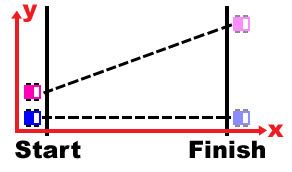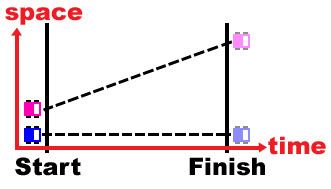
The cool thing about this topic is everything I'm going to discuss here follows from one simple assumption: The speed of light is constant.
That is to say, everyone in our universe who measures the speed of light in a vacuum will get the same value (although Rigellans probably use different units than we do. Heck, even Americans use different units than most of us do.)
That doesn't sound too outrageous, does it? That the speed of light is constant?
But it is, and here's why: If we believe that the speed of light is the same for everyone, that necessarily means that time doesn't run at a constant rate for everyone, and that two different people can measure the length of the same object and legitimately get different answers. It also means two events that seemed simultaneous to you might have happened at different times according to someone else.
Imagine you're sitting on a train moving 75 km/hr. On the track next to yours, another train is moving at 100 km/hr. How fast does the train beside you appear to be moving relative to you?
The answer (to an excellent approximation) is: It moves at (100 - 75) = 25 km/hr relative to you.
Now imagine you're sitting on a train moving at 75% of the speed of light. You look out the window and see a beam of light travelling parallel to your train at 100% of the speed of light. How fast does the beam of light appear to be moving relative to you?
This is the shocking part: That beam of light will appear to be moving at 100% the speed of light relative to you, NOT 25% of the speed of light.
How is this possible? The answer is that because you are travelling so quickly in space, you are moving less quickly through time. In other words, when you look over at that beam of light, you're moving in slow motion and don't realize it.
Below is a pair of diagrams to help you understand how this works. For this first one, imagine that you and a buddy are drag-racing across the desert. You are both driving cars that travel at exactly 100 km/hr.
If you both cross the start line at the same moment, aim directly at the finish line, and travel at the same speed, then of course this race is going to end in a draw, right? Neither of you will be able to pull ahead of the other.
But wait--what if one of you chooses a different path through space?

As you can see, if you drive away at an angle, you will need to travel a longer distance than your friend does to cross the finish line. That means your friend is going to win the race because he's travelling more quickly forward (in what I've labelled the x-direction) than you are.
But let's re-label the dimensions on the above image and re-imagine what's happening. Now you and your friend are drag-racing through time.

This re-labelling isn't such a weird thing for me to do, because our universe has four dimensions--the three spatial dimensions (up/down, right/left, backward/forward), and time.
In my first image, your friend moved in one dimension (purely forward in the x-direction), and you moved in two dimensions (forward in the x-direction, but also sideways in the y-direction)
In this second image, your friend is still moving in one dimension--except it's time, now--and you are again moving in two dimensions (time, but also space.)
To make it clear, your friend is sitting on his couch, and that means he is only moving through time, not space. You, however, are in a rocket ship moving through space while you also move through time.
Remember how, in the first case, you were going to lose the drag race because you hared off in another direction? The same thing goes here. When you travel through space, that forces you to travel less quickly through time.
In other words, time slows down for you when you move through space.
Another way to think about it is that you are moving at the speed of light all of the time (and so is everyone else), but most of that forward motion is sending you through time rather than space. It's only when you start moving quickly through space that you stop moving quite so fast through time.
I'll pause here with the standard caveat that this time-dilation effect isn't measurable until you're moving at a noticeable percentage of the speed of light. Humans can't manage that (yet.) The speed of light is over 10 billion km/hr and our current speed record for manned flight (by Apollo 11) is just under 40,000 km/hr. Time dilation has been seen in accelerated particles, but we're not likely to ever see it happen to a human being.
Now I'll discuss why, when you're travelling at speeds close to the speed of light, time slows down for you.
First, let me explain what light is.
When you run electricity through a wire, that creates a magnetic field around the wire. Likewise, when you wave a magnet around, the motion of the magnet creates an electric field around it.
That's a pretty stripped-down explanation of what's happening, but the thing for you to take away is the idea that a changing electric field creates a (changing) magnetic field and a changing magnetic field creates an (changing) electric field.
Which, if you think about it, creates a chicken-and-egg scenario. The changing electric field creates a changing magnetic field. So wouldn't that in turn create a changing magnetic field that could create a changing electric field that could create a changing magnetic field, etc. etc. to infinity?
Yep. It does. That is what light is: a chain of electric and magnetic fields that create one another and thus zip away into space. (It's also why light is called an electromagnetic wave.)

Now let's return to one of the prior examples. Imagine sitting on a train travelling at 75% of the speed of light--in fact, let's speed up the train. Let's say it's travelling at 100% of the speed of light.
Now imagine looking out your window at a beam of light travelling alongside you. If time didn't slow down for you, what would you see?
You would see that beam of light appear to just hang there in space beside you, frozen.
And that's not possible, because only changing electric fields create magnetic fields and vice versa. If the beam of light appears to be frozen, then it has to stop existing!
To put that another way, light can't stop, or it doesn't exist. That's why you can't catch a bucket of light. When the light hits the bottom of the bucket, it either has to reflect away or be absorbed as heat energy. Light can't sit still.
Thus, to be internally consistent, our universe doesn't allow light to even appear to stop. If we speed up (trying to see light appear to stop), then time slows down for us in such a way that we only see light moving at the same speed it always appears to.
The obvious question is why? Why does our universe have a speed limit? Why does it enforce it in this way, by not allowing us to even see light appear to slow down or stop?
That's a big hairy question, and right now, science doesn't have an answer for it. All we can say is that it is this way, and that the rules are internally consistent for a wide range of phenomenon.
After all, special relativity doesn't just predict that time slows down when you're travelling quickly. It also predicts that objects get shorter in the direction they're travelling and that the object's mass increases. Those are pretty weird, anti-intuitive facts, but again, all these predictions bloom out of that one very simple statement:
The speed of light is always constant. For everyone--no matter how fast or slow they are travelling relative to light.
Now, I've been trying like a mofo to think of some way to explain how the length of a fast-moving object gets shorter without resorting to mathematics, and I even dragged my husband (the black hole guru) into the discussion, but the short answer is we don't know of a way.
I've got a mathematically simple way to demonstrate that a stationary person will measure the length of a fast-moving object to be shorter than a person riding along with that object will. Unfortunately, it's still math, so I've elected to skip it.
Instead I'll show you something that's arguably weirder: simultaneous events aren't simultaneous for everyone.
Here's what I mean by that. Imagine a train car moving at close to the speed of light. It has a light bulb suspended in its centre. At a certain point in time, a person travelling on the train turns on the light.

Because the bulb was in the middle of the train car, the light then strikes the front and the rear walls of the train car at the same time. You can see that in the diagram above.
Here's where it gets odd. Imagine someone standing by the side of the train track watching this happen through the window. Because the speed of light is also constant for this stationary person, they too see the light spreading out at a constant speed in all directions from the bulb's initial position. The light still forms a spherical shape.
However, while the light is spreading, the train car is moving forward.

This is something only relativity gives us. The moving person saw the light strike both walls simultaneously, but the stationary person saw the same light not striking the walls simultaneously. And both people are correct about what they saw!
I'm going to stop there because this post is already massive, but I'll try to post something tomorrow about the symmetries of special relativity--which includes the famous Twin Paradox.
~~~~~~~
Questions? Need clarification on anything? Got a suggestion for something else I could talk about with regard to this subject? Please feel free to drop me a line in the comments!
